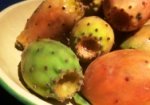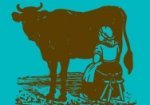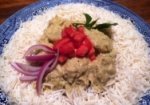Yes folks, it’s a pavlova – or at least we are told it is, in 1930s cook book such as The new Goulburn cookery book and The Presbyterian cookery book of good and tried recipes.
Iconically ‘Australian’
The notion of an Australian ‘national cuisine’ has been debated for decades, with iconic foods such as the ubiquitous Vegemite, lamingtons, Tim Tams and Iced Vo-Vo biscuits being more defining than a uniquely identifiable style of cooking and eating. So too, is the pavlova, despite its origins being hotly contested with our Antipodean cousins ‘across the ditch’.
As the image above suggests, the pavlova was not necessarily the cream-filled fruit-adorned meringue we know today. Notwithstanding that it was part of a Davis gelatine advertising feature, this moulded dessert bears strong similarities to the ‘Australian cream’ recipe in The Schauer Australian Cookery Book (1962 edition):
Australian Cream
Pour lime or any other jelly 1/2 in thick at bottom of mould, when set, pour in 1/2 pint of Strawberry Cream, when set place on top a layer of Vanilla Cream, when set, a third layer of macaroon Cream. Place in an ice-chest till set, turn carefully out.
[For the] Creams – 1/4 pint whipped cream beaten til thick, add 1/4 oz. gelatine dissolved in hot water, then add 1 cup of strawberries, or vanilla essence, or 6 crushed macaroons.
I’m always curious to find recipes which title themselves ‘Australian’ – soups, salads, desserts and so on – and am often flummoxed, wondering what separates them from others of their ilk. Perhaps you have some in your cookbook collections?
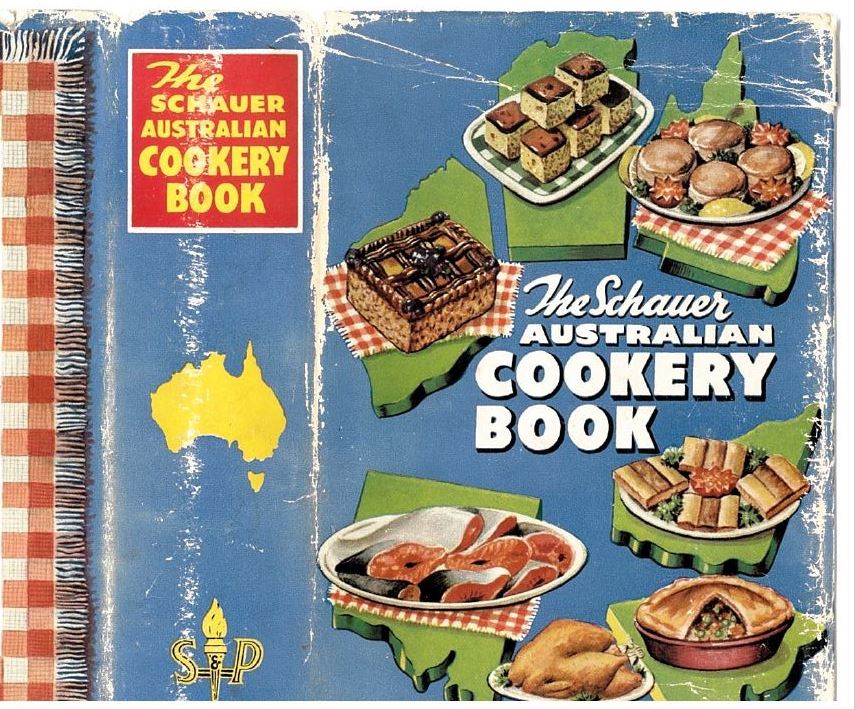
Cover leaf from The Schauer Australian cookery book 1962 edition. W.R. Smith & Paterson Pty Ltd. Brisbane, 1962.
A trifling similarity?
Another Australian specialty in Ms Schauer’s repertoire is an Australian Sundae, which to me has strong echoes of a 19th century trifle, albeit made with tropical fruit:
Australian Sundae
Cut 4 small sponge cakes into squares. Place in glass dish. Pour over seed and juice of six passion-fruit. Slice over 3 bananas. Dissolve and pour over 1 packet of jelly crystals, any colour or flavour. Stand in a cool place to set. Lastly cover with a little whipped cream.
Although trifle-like, made with layered cake, jelly, fruit and cream, this recipe seems to be the most original in nature, and perhaps uniquely Australian? (And I like that the banana slices would be immersed in the layer of jelly, protecting them from browning). I cannot say the same for the ‘Australian salad’ featured in the same book:
Australian Salad
Mix 1&1/2 cups of cooked vegetables, such as 1/2 cup green peas, 1/2 cup diced carrots, 1/4 cup diced ham or lean cooked bacon, 1/4 cup finely chopped parsley or mint, season with pepper and salt and teaspoon of mixed mustard. Combine all carefully through a cup of hot boiled salad dressing*. Chill. Serve daintily in lettuce cups, with a few drops of tomato sauce on top of each.
In essence this reads as a variation of a Russian Salad (usually a combination of cooked vegetables – peas, diced carrots, green beans, turnip, beetroot and ham, with gherkins, capers for piquancy, bound together with mayonnaise) which was popular in the early 1900s. So forgive me for being cheeky, it seems the addition of tomato sauce – albeit used sparingly – makes this recipe (with a sudden recall of a past Prime Minister’s’ ‘fair suck of the sauce bottle’) obviously Australian. (see more on ‘Boiled salad dressing’ below).
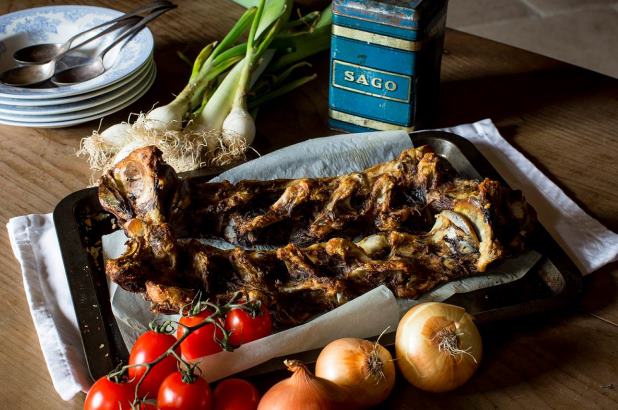
Ingredients for Mrs Maclurcan’s ‘Australian soup’ recipe circa 1898. Photo © James Horan for Sydney Living Museums.
Curious and curiouser
More curious are two Australian recipes from Nina Rouse’s copy of Mrs Maclurcan’s cookery book includes Australian salad dressing and Australian soup. The soup (recipe below) is richly flavoured yet light due to the sago, and therefore well suited to the Australian climate, yet sago soups have been around for at least 100 years by 1898; might it be tomatoes perhaps, that make it characteristically Australian in the 1890s? In the early 1800s tomatoes were rare and exotic, but prolific enough to make them into sauces and chutney by the latter half of the century. This hardly seems worthy of assuming the title, but it is a delicious soup, nonetheless.
Australian soup
Ingredients
- 50 g (1/4 cup) sago or tapioca
- 1 litre (4 cups) good-quality beef stock (or consommé)
- 2 large ripe tomatoes, chopped and rubbed to a pulp through a colander
- crusty bread, to serve
Note
What makes this recipe from Mrs Maclurcan's cookery book 'Australian' is unclear, but it is surprisingly delicious, and has a slightly gelatinous, lip-smacking quality. The original recipe uses tapioca but sago works equally well.
Serves 4
Directions
| Grind the sago in a clean coffee or spice grinder, or crush it between two layers of brown paper with a pestle. (If you use a mortar the sago will fly everywhere!) There is no need to grind it to a powder; a little texture adds to the character of the soup. | |
| Bring the stock to the boil in a saucepan over medium heat, add the crushed sago and simmer until the sago is quite clear, stirring the soup frequently to break up any lumps that form. When the sago is cooked through, add the tomatoes and simmer for another 10 minutes. Season to taste and serve with crusty bread. | |
Boiled is best?
The boiled fruit cake was an Australian innovation, according to Bold Palates (Barbara Santich, 2012) but I’ve not found any mention of boiled salad dressings being uniquely ‘ours’ – they were known in America in the early 1900s, but I’m not sure when they originated.. Mrs Maclurcan’s ‘Australian salad dressing’ may well have been its pioneer in Australia – it starts to appear more commonly in local cookbooks from the 1930s. Both it, and the boiled salad dressing mentioned in the Schauer Australian salad recipe above, are a roux style bechamel-type white sauce enriched with mustard, sugar, egg yolk and finished with vinegar – something of a cheats mayonnaise perhaps. I’ve not yet put it to the test.
Australian salad dressing
4 tablespoons butter (about 60g); 1 tablespoon flour; 1 tablespoon milk; 1/2 cup vinegar; 3 eggs, beaten; 1 teaspoon mustard; pinch white pepper
Melt the butter in the saucepan until it is oily, add the flour and stir until smooth. Add a little milk, stirring as it boils up and is incorporated into the butter mixture. Add the other ingredients, and stir until it thickens like custard (ie coats the back of a spoon). Cool and refrigerate.
Sources and further reading:
The Schauer Australian cookery book. (First published 1909). W.R. Smith and Paterson Pty. Ltd. Brisbane, 1962.
Mrs Maclurcan’s cookery book (First published 1898) 1903
Bold Palates, Barbara Santich, 2012.

 Print recipe
Print recipe